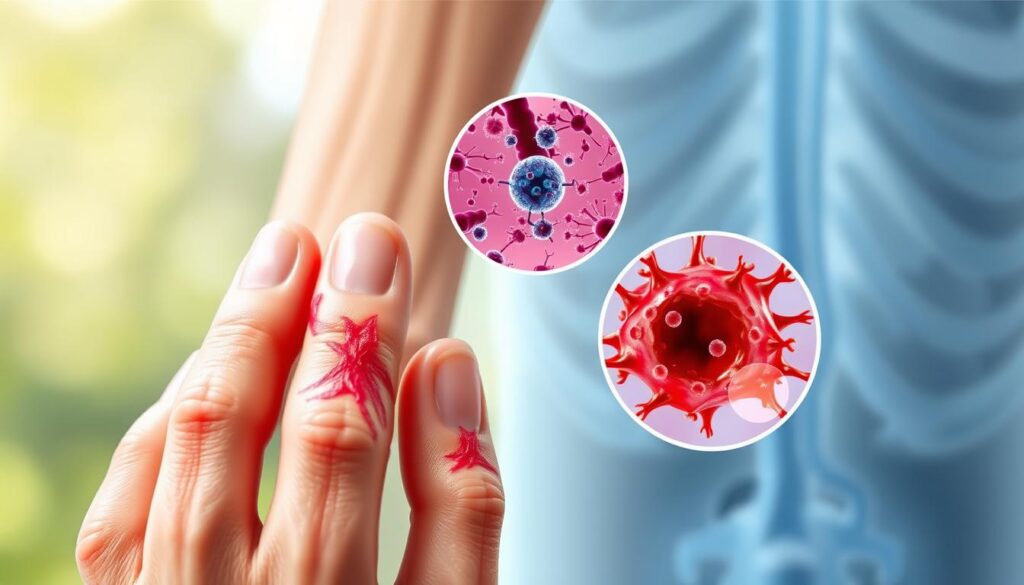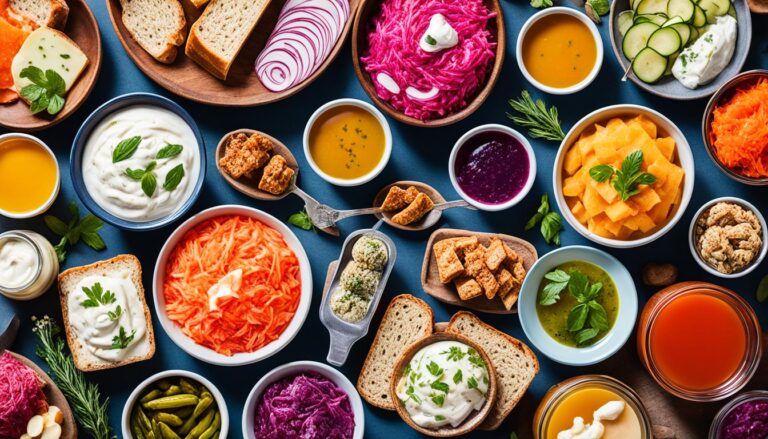Modern lifestyles often include hidden triggers that fuel chronic inflammation a silent contributor to numerous health challenges.
Emerging research reveals that strategic food choices can powerfully influence bodily responses, potentially easing symptoms of arthritis, digestive issues, and metabolic disorders.
This science supported approach emphasizes nutrient rich whole foods over temporary restrictions. Unlike trendy eating plans, it focuses on sustainable changes that become lifelong habits. Healthcare providers increasingly recognize its value in managing chronic conditions and enhancing vitality.
By prioritizing colorful produce, healthy fats, and lean proteins while minimizing processed items, individuals may experience reduced inflammation markers within weeks. Clinical studies show such patterns support immune function and cellular repair processes naturally.
Key Takeaways
- Science-backed eating patterns can reduce harmful inflammation
- Focuses on nutrient-dense whole foods rather than strict limitations
- Supported by healthcare professionals for chronic condition management
- Promotes sustainable lifestyle changes over quick fixes
- May lower risks for inflammation-related health complications
- Combines modern research with traditional dietary wisdom
- Offers practical strategies for personalized implementation
Introduction to Anti Inflammatory Diets
Imagine your meals as daily votes influencing internal balance. This approach transforms eating from mere nutrition to active wellness management. Unlike restrictive plans, it emphasizes strategic substitutions that work with your biology.

Overview of the Diet Concept
This eating pattern focuses on foods that calm cellular responses naturally. Colorful fruits, leafy greens, and omega rich fish take center stage. Processed snacks and sugary drinks get replaced with whole-food alternatives.
Nutrition experts highlight its flexibility: It’s about crowding out inflammatory triggers, not memorizing rules. Studies show consistent adherence can lower CRP levels a key inflammation marker within 30 days.
Why Inflammation Matters for Health
Acute inflammation helps heal cuts and fight infections. Problems arise when this response becomes constant. Chronic activation damages tissues and disrupts organ function over time.
| Type | Duration | Health Impact |
|---|---|---|
| Acute | Hours to days | Essential protection |
| Chronic | Months to years | Disease catalyst |
Persistent inflammation links to heart conditions, joint pain, and metabolic issues. Food choices either fuel this fire or help extinguish it. Research confirms dietary changes can alter inflammatory pathways at the genetic level.
Understanding Inflammation and Its Impact on Health
Persistent internal fires don’t always announce themselves with visible smoke. Chronic inflammation operates at cellular levels, quietly influencing multiple systems over time. This hidden process creates fertile ground for various health challenges.

Chronic Inflammation and Disease Connections
Research reveals startling links between prolonged inflammatory states and major illnesses. A 2023 Johns Hopkins study found:
| Condition Type | Examples | Inflammation Role |
|---|---|---|
| Metabolic | Type 2 diabetes | Impairs insulin response |
| Cardiovascular | Heart disease | Damages arterial walls |
| Neurological | Alzheimer’s | Promotes plaque formation |
Autoimmune conditions like rheumatoid arthritis and Crohn’s disease demonstrate how misfiring immune responses create destructive cycles. Even osteoporosis and depression show inflammatory components in recent studies.
Signs and Symptoms to Watch For
Your body sends subtle signals when inflammation persists:
- Unexplained fatigue lasting weeks
- Swollen joints or morning stiffness
- Skin changes like persistent rashes
- Digestive discomfort after meals
Many people dismiss these warnings as normal aging. However, when multiple symptoms combine especially with abdominal bloating or cognitive fog professional evaluation becomes essential. Blood tests measuring CRP and ESR levels often reveal hidden inflammatory activity.
Key Principles of the Mediterranean and DASH Diets
Nutritional science offers proven paths for managing inflammation through culturally rooted eating patterns. Two approaches stand out for their research-backed benefits and practical application.
Core Components of the Mediterranean Diet
This eating pattern centers on plant-based foods and heart-healthy fats. Daily meals feature colorful vegetables fruits, and whole grains like farro or bulgur. Olive oil replaces butter as the primary fat source while fatty fish provides essential omega-3s.
Legumes and nuts serve as protein staples, with moderate dairy from yogurt or cheese. Herbs like oregano and rosemary add flavor without excess salt. Studies show this combination reduces cardiovascular inflammation by 30% compared to standard Western diets.
Benefits and Focus of the DASH Diet
Originally designed to combat hypertension, this plan emphasizes sodium control and mineral-rich foods. While sharing many elements with Mediterranean eating, it prioritizes low-fat dairy and explicit sodium limits 2,300mg daily.
| Feature | Mediterranean | DASH |
|---|---|---|
| Primary Focus | Heart health | Blood pressure |
| Key Components | Olive oil, fish, herbs | Low-fat dairy, potassium |
| Health Impact | Reduces heart disease risk | Lowers inflammation markers |
Both approaches minimize processed foods while maximizing nutrient density. Research confirms adherents experience fewer inflammatory episodes and improved metabolic markers within 6-8 weeks.
The Anti Inflammatory Diet What to Eat and What to Avoid
Strategic food choices serve as building blocks for reducing inflammatory responses. Consistency matters more than perfection gradual shifts toward nutrient-dense options create lasting benefits. Omega-3 rich fish and colorful plants form the foundation of effective eating patterns.

Powerhouse Ingredients for Wellness
Prioritize these inflammation fighting champions:
- Fatty fish salmon, mackerel – provides essential omega-3 fatty acids
- Leafy greens and berries packed with antioxidants
- Whole grains like quinoa rich in fiber
- Walnuts and flaxseeds plant-based omega-3 sources
| Food Type | Examples | Key Benefits |
|---|---|---|
| Protein Sources | Wild caught salmon, lentils | Reduces CRP levels |
| Healthy Fats | Avocados, olive oil | Supports cell repair |
| Complex Carbs | Sweet potatoes, oats | Stabilizes blood sugar |
Common Dietary Triggers
Certain ingredients can activate inflammatory pathways:
- Processed meats bacon, deli slices high in nitrates
- Commercial fried foods cooked in unstable oils
- Refined sugars spikes insulin levels
Research shows eliminating trans fats decreases inflammation markers by 40% in some populations. Individual reactions vary tracking symptoms helps identify personal triggers like gluten or dairy.
Exploring Plant Based and Vegan Anti Inflammatory Options
Shifting toward plant powered meals unlocks new possibilities for managing inflammation. Research confirms these eating patterns reduce cellular stress when centered on whole ingredients rather than imitation products.
Nature’s Pharmacy on Your Plate
Studies reveal plant-based diets lower key inflammation markers like CRP and interleukin-6. A 2017 review showed people maintaining vegan or vegetarian eating for two years averaged 30% lower inflammatory biomarkers than meat-eaters. This stems from:
- Antioxidant rich berries and leafy greens
- Fiber packed legumes and whole grains
- Phytochemicals in brightly colored produce
These components work synergistically to calm overactive immune responses. Nutritionists emphasize: It’s not about removing animal products – it’s about crowding meals with healing compounds.
Building Balanced Plant-Powered Meals
While plant-based eating offers advantages, nutritional gaps can emerge. Key considerations include:
| Nutrient | Plant Sources | Daily Goal |
|---|---|---|
| Vitamin B12 | Fortified cereals | 2.4 mcg |
| Omega-3s | Chia seeds, walnuts | 1.6 g |
| Iron | Lentils, spinach | 18 mg |
Processed vegan items like fries or cookies undermine benefits. Focus instead on meals combining beans, quinoa, and roasted vegetables. Gradual transitions prove most sustainable – start with three plant-based dinners weekly.
Boosting Health with Anti Inflammatory Herbs Spices and Oils
Kitchen cabinets hold ancient secrets for modern wellness. For centuries, cultures worldwide have harnessed plants’ healing properties through culinary traditions. Current studies validate how specific seasonings and oils calm inflammatory pathways while enhancing flavor profiles.
Nature’s Flavorful Remedies
Turmeric’s active compound curcumin demonstrates particular promise. Research indicates 1,000 mg daily may ease joint discomfort and protect bone health. Cinnamon regulates blood sugar, while black pepper boosts nutrient absorption by 2000% when paired with turmeric.
Cardamom supports digestion, and rosemary contains antioxidants that combat cellular stress. These ingredients work synergistically sprinkling them into meals creates cumulative benefits over time.
Essential Fats for Cellular Health
Healthy oils like extra-virgin olive oil contain oleocanthal, a compound mimicking ibuprofen’s effects. Omega-3 fatty acids in walnuts and flaxseeds reduce inflammation markers linked to heart disease. Cold-water fish remains the richest source of these essential fats.
Replace processed oils with avocado or sesame varieties for high-heat cooking. Balanced fat intake supports hormone production and nutrient absorption, creating foundational wellness benefits.





